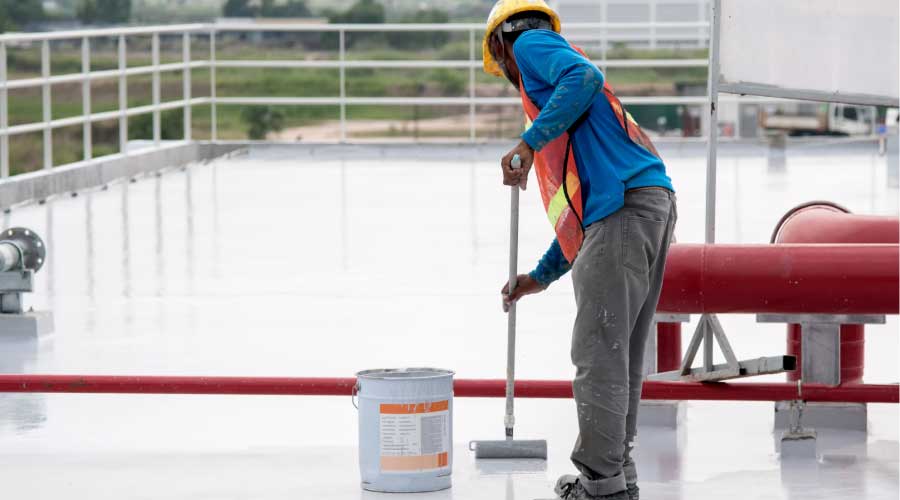Does One Size Fit All?
Although it might sound good on paper, standardizing a roofing specification is risky business for most building owners
One way building owners may try to save money on roofing costs is to use the same set of specifications at multiple buildings. The thinking behind it is easy to understand: By reusing a set of specifications over and over, the building owner can save on design fees and volume purchasing can include discounted material prices and special pricing from contractors.
It sounds good on paper, but how well does it work in the real world? When the buildings are nearly identical from place to place — such as fast-food restaurants and big-box retail stores — and the square footages are large, this approach can create substantial discounts. Giant retailers such as Wal-Mart and Target use this approach almost exclusively. They use the same roofing materials and a select group of contractors, or have their own in-house personnel, throughout the entire United States. Given the large number and square footage of stores involved, the savings of this approach are significant.
Advantage for Contractors
Another major reason for standardization is contractors. Installing the same roof on multiple buildings will help the contractor understand the system and the tricks of the trade that will allow them to install it well. As the old saying goes, practice makes perfect.
The approach also improves the contractor’s ability to repair the roof. One repair manual will cover all buildings, allowing control over how repairs are done. Contractors who know how to repair one building’s roof will know how to repair another. (This becomes very important with unfamiliar roof types. Some roof repairs can actually cause more damage than they solve. A good example of this is the roofer who “patches” a PVC or EPDM roofing membrane with asphalt roofing cement.)
Standardization over multiple buildings may also help in responsiveness to warranty claims. If the manufacturer knows that they are part of a standardized specification, they are more likely to respond well because they know that their material will be installed on future buildings as long as the materials continue to perform.
But what about owners who only have a few facilities? Does the same logic work for them? Maybe. As far as contractors are concerned, the amount of work they will get directly affects their willingness to create discount pricing and to spend the time and money to train workers to install the roofing system correctly. Roofing three buildings might not be enough to warrant special pricing. Roofing 30 buildings might.
With manufacturers, the square feet of materials sold can get their attention. This is not to say that manufacturers will not respond well and quickly to warranty claims anyway, regardless of the number and size of the roofs; it is just that a million square feet is much more noticeable to a manufacturer than a thousand.
Beyond Standardization
Among all the reasons for standardizing specifications, one stands out — to save money. A key reason that large retailers can reuse specifications is that they have in-house staff to prepare them. The in-house staff can make the changes to the standard specifications needed to adjust the roof design to the specific locale. This means that the specifications are not free, but the cost of an in-house staff is less because the retailer needs them for other reasons as well.
What’s more, there are no questions of copyright protection in their work. This is not true of outside consultants’ services, unless it is agreed to in the contract. Reusing a set of consultant’s documents violates copyright laws. Design fees have to be paid if those documents are reused; however, the fees may be less per building if specifications are written for multiple buildings.
What about using manufacturer’s free specifications? True, there are no design fees involved and the specifications can be used as many times as necessary. But remember, manufacturer specifications are intended to cover all situations in all locations of the country. This means that someone needs to pick and choose which pieces of the manufacturer’s documents apply to the specific building to which the roof will be applied. Usually, when someone is unwilling to pay for a consultant to design the roof, the roofing contractor ends up doing that job. That can be good or bad, depending on the contractor.
Roofing contractors are in business to make money. Even the best roofers have competitors who undercut bids because they are unlicensed, use inferior labor or go without insurance. Or they propose cheap, inferior roof systems, install them, get paid and disappear when the problems start. So contractors that would, if given a chance, install a perfectly good roofing system, are pressured into doing the minimum possible to stay competitive with the lower-tier roofers.
Customizing Specifications
Using a manufacturer’s specification and letting the roofing contractor customize it to the needs of the building can work if the roofers being considered are upper-tier contractors. But it’s a gamble because even the best roofers have lousy crews occasionally. Facility executives who take this route need to be extremely careful when choosing contractors to bid.
The other option is to customize the manufacturer’s specification in-house. That’s not as easy as it may sound. No two buildings are identical. Each one has its own requirements. A look at some of these building-specific needs can help to demonstrate why standardized specifications and details usually don’t work.
Codes are one obstacle to setting standards that apply to multiple locations in the United States. Although most of the United States is now under the International Building Code, the code permits local amendments. What is supposed to be standardized over the country isn’t really because each state and local jurisdiction can make alterations to suit its own needs.
Some states, such as Florida, and some localities have never adopted an international code. That means specifications can’t be standardized — at least not legally — for multiple jurisdictions.
Then there’s the issue of fire codes. A building may or may not need a Class A fire rating. If it doesn’t, why install a roof with a Class A rating? It costs more to install a Class A roof than one rated Class B. And reducing costs is the reason for trying to do standardized specifications.
Unless all buildings are in the same fire zone and covered by the same code jurisdiction, the law requires customized specifications. The big-box retailers have the architectural staff to watch the codes and keep the installations in line with the code requirements.
Another hurdle is climate. Some roofing systems are better suited to some climates than others. What works in Arizona doesn’t necessarily work as well in Texas, North Dakota, Virginia or Oregon. A place where hail is as big as golf balls has completely different priorities than an area where roofs are subjected to rapid 60-degree temperature drops. A roof located in a place where the temperature falls to –20 F is not going to have the same requirements as one located where it soars to 120 F. A place where it rains 200 days a year is going to impose different requirements from one that only sees rain 20 days a year.
Climate accounts for the most extreme variations in what’s best for a roof. So unless all of the buildings are close, it’s better to individualize the roofing systems.
Insurance is another factor to consider, especially if buildings in a portfolio aren’t all insured by the same company.
For example, if any are insured by Factory Mutual, the roofs must meet their specific requirements. While this is not necessarily a bad thing — their requirements are really very good for roofs — other roofs might not need to meet Factory Mutual requirements and could well have a less-costly system installed.
Building owners considering standardized specifications should be aware of the specific insurance requirements for roofs.
Many Buildings, Many Roofs
The buildings themselves present another complication. Each one may have a different deck requiring a different installation method. Some projects require a tear-off; some don’t. A roof may need extra drains or tapered insulation to improve drainage. One roof might need extra protection from foot traffic and vandalism, while another might have equipment requiring custom flashing details. There might be issues of structural movement or leakage in parapets or other areas not related to the roofing.
What’s more, a general set of specifications and manufacturer’s details will not cover individual flashing requirements, and this is precisely the reason failures most often occur.
All of these issues vary in severity, location and extent, but all need to be addressed. With the better roofing contractors, these issues are less likely to cause problems.
Also keep in mind that there are many types of roof systems and multiple variations within each category of roof systems.
What’s the best choice: built-up, modified-bitumen, single-ply, coated-polyurethane-foam, standing-seam metal or something else? If it’s a built-up system, is coal tar better than asphalt built-up? Which modified-bitumen system should be selected: SBS, SEBS or APP? Which single-ply: PVC, EPDM, EIP, TPO? Should the roof be mechanically attached, hot mopped, fully adhered, ballasted, torch-applied or liquid-applied? Is insulation required and, if needed, should it be polyisocyanurate, polystyrene, perlite, wood fiber, foamed glass, glass fiber or polyurethane? Which of the more than 200 roofing manufacturers should be picked?
Matching Contractors
Finally, it’s important to think about contractors. Many contractors prefer one type of roofing system rather than others, and their expertise is installing those systems. In major markets, there are usually enough contractors to bid on any system chosen. However, in smaller markets the expertise might not exist to install the particular system that has been selected as the standard. The result will be either a poorly installed roof done by contractors unfamiliar with the product, or contractors from other areas coming in to do the job, which will increase the cost, or force a change to the standardized specification.
Some building owners prefer nationwide roofing contractors to go with their standardized specifications. While the pricing for a national account might be better, the quality of the workmanship might not. Remember that each local branch is only as good as the mechanics that are on the roof installing the materials. Where one office might be excellent, the next might not be very good.
The best candidates for standardizing specifications are large property owners with many similar buildings with similar construction and an in-house staff to modify the specifications as needed. Even better is to have in-house installers thoroughly trained on the exact system to be installed. Owners of multiple smaller buildings can benefit from standardization if:
- They have a competent consultant to modify the specifications as needed and to warn them when the specifications are not appropriate for a particular building
- They are in major markets so they can find enough eligible bidders
- The buildings have at least some similar construction characteristics.
Be forewarned, however, that sometimes the cost of modifying a standard specification is more than developing a new specification to match the building requirements.
For other owners, standardized specifications are risky, especially if the buildings are in multiple locations, are small and have different construction. Using a standard specification will produce some good roofs and some inappropriate ones.
Contributing editor Karen Warseck, AIA, is president of Building Diagnostics Assoc., a Hollywood, Fla., architecture firm.
Related Topics:











